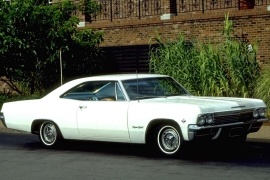CHEVROLET Impala Coupe Models/Series Timeline, Specifications & Photos
First production year: 1958
Engines: Gasoline
Body style: Coupé (two-door)
Chevrolet introduced the fourth generation of the Impala in 1965 and offered it with the already famous Super Sport package.
Being the first American car to be produced in more than one million units in a single year after WWII was not an easy task. But that didn't make GM slow down the car's development process. Thus, in 1965, the automaker brought the fourth generation of the Impala SS on the market and made it even better than before.
On the outside, the car featured a more rounded exterior design, with a four-headlights design and blinkers placed into the bumper area. In addition, the chromed grille with horizontal slats sported the bow tie in the middle. For the Super Sport version, Chevrolet added dedicated badges on the front fenders. On the coupe version, the car featured frameless side windows, creating a faux-cabriolet design. At the back, the automaker installed six round taillights.
Inside, there were two bucket seats at the front, separated by a center console. It was an unusual interior feature since most vehicles didn't have something like that at that time. At the back, GM installed a bench wide enough for three people, although the sloped greenhouse didn't give too much headroom. The instrument cluster was also innovative, with a round tachometer on the left and a linear speedometer fronting the driver.
Under the hood, the Impala SS was the first to offer a 6.5-liter V8 (Turbo-Jet) engine that developed up to 425 hp, depending on the compression ratio and camshaft design.
1958 was a year of recession, and many carmakers had to cut production costs, but Chevrolet doubled down and offered a special trim level for the Bel Air, namely Impala, which was available as a convertible or a hardtop coupe.
Even though it was based on the Bel Air, it looked different, and, due to its success, the carmaker decided to split the Bel Air and create a new lineup: the Impala.
In 1958, General Motors had its 50th anniversary and decided to create special versions for the brands in its portfolio. The Impala was created as the top version for the Bel Air, and it was available either as a convertible or a Sport Coupe. It featured quad-headlights at the front and looked similar to the Bel Air up to the A-pillars. Yet, the greenhouse was shorter, and the rear deck longer than the rest of the Bel Air models. In addition, its deeply sculptured rear fenders marked a departure from the large fin tails of other American cars from that era. Finally, at the back, the Impala sported three taillights, while the rest of the Bel Air featured just two, or one for the station wagon version.
Inside, Chevrolet installed a taller instrument panel than the rest of the dashboard. It was fitted with a speedometer and a few gauges. In the middle of the dash panel, the Impala sported a radio and the controls for the ventilation system. At the front, the cabin featured a bench seat with individual adjustments for the seatbacks. At the same time, in the rear, the carmaker installed a bench for two with a center armrest.
Under the hood, the Bel Air Impala received a choice of two engines with various power outputs, depending on the carburetor system. The top version was fitted with the newly introduced 5.7-liter V8 fed by three two-barrel carburetors that offered 280 hp. There were 125,480 1958 model-year coupes produced.

